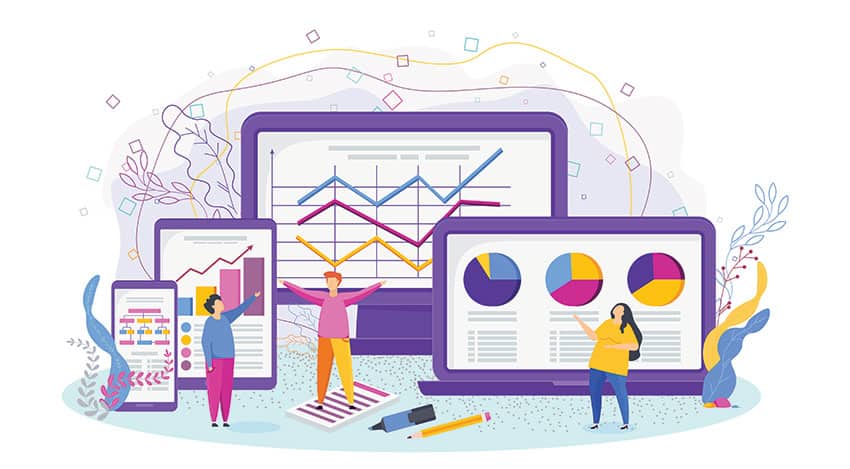7 Benefits Of Analytics In Ecommerce Industry

Understanding the Benefits of Data Analysis in Ecommerce
Data analysis can help you understand your customers’ needs well in advance. What they want to buy from you, at what time during the day, and how much they would be willing to spend. Analyzing data allows you to derive all these conclusions and gives insight into the problems and issues that may crop up from time to time, well before a customer brings it to your notice. Think of analytics as magic beans that, once sown, can help you know what is working and speed up the decision-making process.
7 Ways Analytics Can Help Ecommerce Industry
For the eCommerce industry, analytics can help in 7 ways to spot and tend to gap issues:
Maintain a Robust Supply Chain
Customers shop online because of the convenience it brings. Saving time and money are the two major benefits of shopping online, but this means that maintaining a robust supply chain is essential for a business. This involves displaying products accurately and ensuring enough inventory to supply all the orders.
If your inventory is not logged properly, it will result in a slower delivery that will eventually reduce the customer’s level of satisfaction. On the other hand, having too much inventory can take up more space and increase storage costs. Striking this balance between supply and demand is important, and analytics can help you do it.
Measure the Market
Data related to online marketing analytics is required by retailers. Spending hundreds or thousands of dollars on online marketing campaigns is pointless if you cannot determine their effectiveness. Analytics help you figure out if your marketing strategy is working or not.
Analytics measures ad clicks, engagement time of site visitors, channel data, and promotion effectiveness. Measuring such metrics allows your ROI to be determined and your marketing strategy tuned accordingly.
Minimize the Risk of Fraud
The analytics keeps track of consumer behavior and purchase patterns. If there is any purchase made that seems out of the ordinary, analytics can help you flag it. Think of credit card providers giving you a call to make sure a particular transaction that seemed fishy to them was done by you or not. If it is not, they can always cancel it at their end and take the necessary steps to secure your account.
Forecast Inventory for the Next Season
As an eCommerce retailer, you need to know whether having a product on your website is worth the cost of physically maintaining it in your storehouse. Ecommerce analytics helps you determine the volume of sales of your products, predictions of sales for the future, the customer satisfaction rate, and more. This helps you determine how many units of a product you will need for the next cycle, which products must be included in your inventory, and which need to be discarded.
Analyze Buyer Sentiment
Retailers everywhere need to understand the types of customers who avail of their services and purchase their goods. Demographics, behavior, and churn cases are essential metrics in determining buyer sentiment. Such analysis is useful in determining the product strategy and any adjustments needed in order to meet the desired revenue and general company goals. Read more about analyzing buyer sentiment and behavioral segmentation here.
Personalized Customer Experience
Analyzing buyer sentiment can help you personalize a visitor’s shopping experience. Some visitors like to shop during the day, while others are nightbirds who add products to their carts in the middle of the night. Some users avail of discounts, hunt for deals of the day, and curate their shopping carts accordingly. The others are not distracted by any sales or discounts, know what they want, and head straight to that section without any delays.
So, when such diverse customers visit your website, you cannot show them the same landing page. Customizing the user experience to show them a structured landing page that keeps them engaged and converts them by making them purchase may be achieved with the use of analytics.
Optimizing Price Model
In the eCommerce industry, product pricing is based on the product’s demand, availability, and how competitors price it. Predictive analytics may be used to analyze pricing trends and determine the optimum price for a product to maximize profit from sales. Amazon is the best example of how an online retailer uses predictive pricing and optimizes pricing models.
Analytics and Reporting with ShopAgain
ShopAgain is your all-in-one eCommerce marketing solution to help optimize your marketing strategy. It builds behavioral segments for you in order to help you recover abandoned carts, and cross-sell and upsell to your consumers.
Start your 14-day free trial here.
Frequently Asked Questions
How can data analytics help your eCommerce business?
Data analytics can help optimize your sales and marketing strategies, upsell and cross-selling for increased profits, and personalize the user experience to increase conversions.
What are the benefits of using analytics?
Analytics allow you to determine whether your marketing strategy is working, personalize your customer’s online shopping experience, and predict how much inventory you will need for the next cycle.